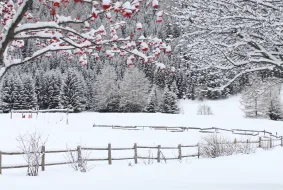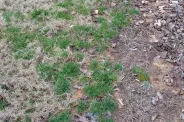I don’t know about you all, but around the time of the holidays a few weeks ago, it seemed more to me like April than December. Getting out the golf clubs made more sense than heading for the ski slopes!
But, according to the professional meteorologists, we are in an El Nino weather pattern, which means a cold and possibly snowy winter (no school for the kids!) is on its way.
While most landscape plants in our area are hardy to 10-15 degrees, for sensitive plants or during severe, unusual cold snaps, they might need special protection. So what can we do to minimize damage to the landscape during the winter?
First, applying pinestraw or mulch to the beds offers some protection for the roots of bushes and trees. While most bushes and trees planted here in Atlanta are hardy enough to withstand normal winter temperatures, a severe extended freeze can freeze the ground deep enough to kill the roots of more sensitive plants. Mulching can help prevent this.
The catch phrase in real estate, “Location, location, location”, also applies to landscape planting. Most cold fronts come from the northwest and therefore the best location to put in sensitive plants is on the southeast side of a building or home. Even during periods of extreme cold, plants here are at least protected from the northwest winds.
During the January 2014 freeze (5 degrees for 2 nights in a row), the gardenias, indian hawthorne, and lorapetalum all were severely affected by the cold. However, the ones that were planted out of the way of the wind seemed to do better.
Covering your sensitive plants with tarps or blankets can also protect them from the cold. This can help prevent them from getting as cold as the surrounding air. Even being only 5 degrees warmer can make the difference between a plant surviving or dying.
If all efforts have failed and some of your plants have suffered frost damage, you might have the inclination to cut them back. However, it would be better to give them most of the next summer to see if they will recover.
In 2014, most of the gardenias were frozen from the ground up and suffered severe frost damage. However, most of them recovered by June and were sprouting new growth, albeit 2 months later than normal. So give your plants a chance to recover!
A final item not to overlook is your irrigation system. Make sure your irrigation system is winterized, which involves blowing out the water from the system to prevent it from freezing and cracking the pipes. Your professional irrigation company can easily handle this.
So this winter, stay warm and hopefully implement some of these strategies to keep your landscape plants protected from the cold!



